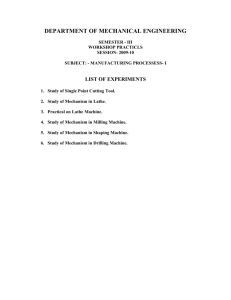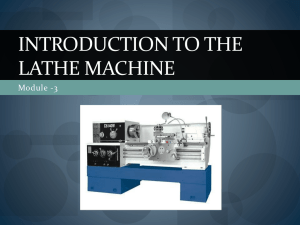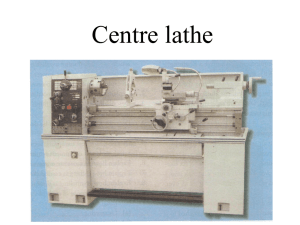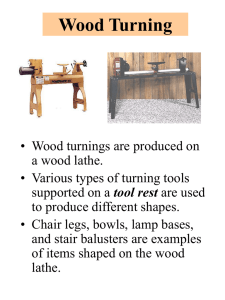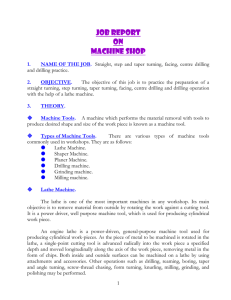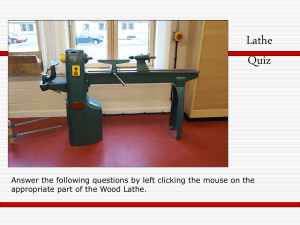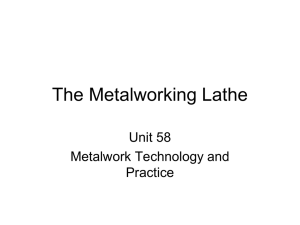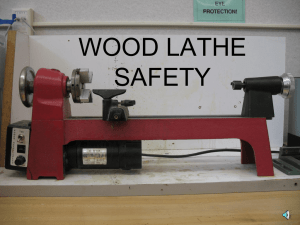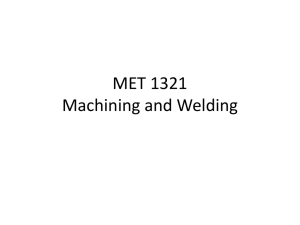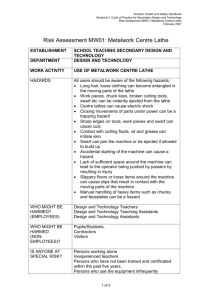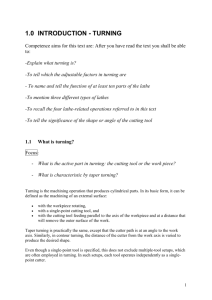EME-Unit-5-Lathe-and-drilling-machines-by-Kalyan
advertisement
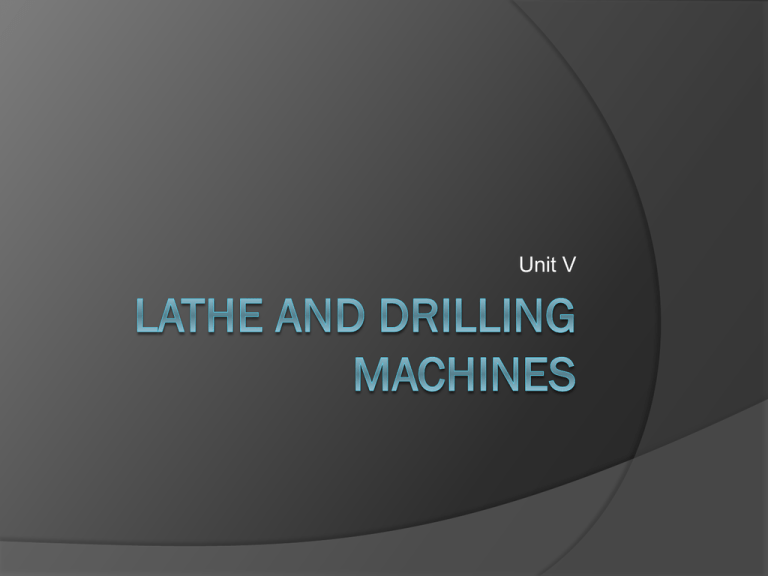
Unit V Manufacturing process It is a process which involves the conversion of raw materials into desired product. Methods involved Material removal Assembly or joining process Finishing process Material removal operation It involves removal of extra material from the given material to obtain required dimension of product. Material removal can be in small scale or large scale small scale – fitting, craftwork etc large scale – industrial products. Tool A tool is a device use to carry out various manufacturing operation. Hand tools. Machine tools Tools Hand tools Machine tools Hand tools Tools which are used manually by human effort. Files hacksaw Machine tools Defined as power driven machine which accomplishes the cutting operation or machining operations. Lathe A lathe is machine tool employed generally to produce circular objects. Operations Drilling Grinding Shaping Milling Classification of lathe Engine lathe Speed lathe Turret lathe Capstan lathe Automatic lathe Computer numerically controlled lathe. Lathe principle of working A lathe works on the principle that “a cutting tool can remove chips from the rotating work pieces to produce circular objects”. Figure shows a work holding device known as chuck and is rotated a very high speed. A V-shaped cutting tool is held against the work piece. When the tool is moved parallel to axis of work piece material is removed. Lathe Major components Bed Head stock Tail stock Carriage assembly Main drive Bed It is the foundation part of lathe and supports all its parts. Top of bed has a guide way which is machined to precision. Head stock Main spindle projects out from headstock. Housing comprises of feed gear box and cone pulley. Rigidly mounted on bed. Tail stock Movable part of the lathe that carries dead centre. Main function is to support the free end of the work piece. Also used to clamp tools like twist drill and reamers for making holes. Tailstock is mounted loosely on guide ways can be moved and locked in position. Carriage assembly Saddle Cross slide Compound rest Apron Tool post Saddle H shaped casting that slides over the outer set of guide ways Serves as base for cross slide. Cross slide It is mounted on the saddle. Enables lateral movement of cutting tool laterally by means of cross slide handwheel. Compound rest Mounted on top of cross slide and supports the tool post. It can be swiveled at an angle to perform taper turning operation. Tool post It is used to clamp the tool holder in position. Apron It is the part which is fitted saddle, facing operator. It houses levers, hand wheels mechanism for manual and automatic movement of carriage assembly. Main drive It is an electric motor which drives the spindle through transmission system. Other component Lead screw It is a rod which runs longitudinally in front of lathe bed. The rotation of lead screw moves the carriage to and fro longitudinally during thread cutting operation. Lathe specifications Maximum diameter of the workpiece that can be revolved over the lathe bed. Maximum diameter and width of the workpiece that can revolve over gap in bed. Maximum length of workpiece that can be mounted between centers. Overall length of the bed. Lathe operations Turning Taper turning Facing Thread cutting Knurling Turning It is an operation in which the workpiece is reduced to the cylindrical section of required diameter. Operation is carried out with a single point cutting tool. Work piece is supported between the two centers permit rotation of workpiece. Tool is fed perpendicular to the axis of workpiece to a known depth and then moved parallel to axis of work. Facing An operation performed on lathe to generate flat surface. Direction of feed is perpendicular to the axis of the lathe. Length of the work should not be extended more than 1.5 times the diameter of the work piece. Knurling Operation performed on lathe to generate serrated surface. Tool used is called as “knurling tool”. Tool consist of one upper roller and one lower roller which contains the impression. Tool is set in such a way that both rollers touch the work. Low speed of about 60 to 80 rpm and feed is 0.38 to 0.78mm/revolution. Taper Turning It is the operation of reducing the diameter of the workpiece gradually along its length. Different types of Taper turning 1. Compound slide swivelling method 2. Tailstock offset Taper Turning by Swiveling the Compound Rest Axis of the tool is moved inclined to produce the required taper. Compound rest which supports tool post is swiveled at required taper angle and locked. Taper Turning by Tailstock offset In this method the workpiece is inclined with respect to the lathe axis. Tool movement is in line with the lathe axis to produce taper. Tail stock is shifted by a small distance called offset. Thread cutting A thread is a helical shaped groove formed on cylindrical surface of workpiece. Thread cutting is an operation performed on lathe to produce threads by using a tool whose shape will be same as that of thread. Drilling Drilling is an operation to produce a cylindrical hole in workpiece. Tool used is called as “drill bit”. Tool is held on the tailstock and stationary. Work is held in chuck. Tool is fed against the revolving work by rotating hand wheel.
